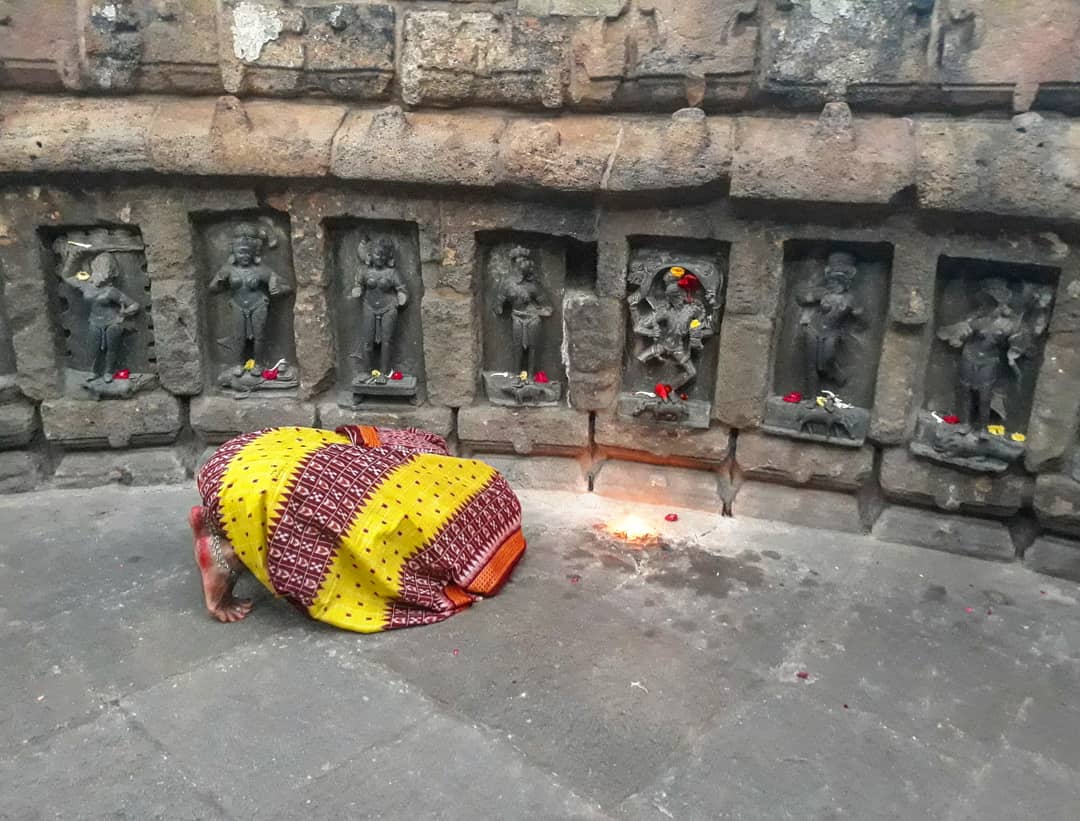64 Yoginis: Black Magic And Beyond

Bhubaneswar: Only a few kilometers away from Bhubaneswar, in contrast to the city’s hustle and glitter, is Hirapur, a quiet and eerie town and the abode of the angry Indian goddesses, the Chausathi Yogini Temple.

Also known as Mahamaya Temple, this hypaethral (having no roof) shrine facing the East was first discovered in 1953 by Kedarnath Mahapatra, a curator at the Odisha State Museum. Three years later, the Archaeological Survey of India took over the temple.
Made out of local coarse sandstone, the temple houses 64 striking and jaw-dropping sculptures of goddesses, yoginis, said to be different forms of Goddess Parvati.

The circular shape gives it a different touch. At the centre is a Chandi mandap with four figures of Lord Shiva’s Bhairav forms. The circular structure of the temple represents the female reproductive organ – yoni, while the pillar at the centre symbolises the male reproductive organ. The entrance of the temple is a tiny gate. One has to bend to enter. There are two striking carvings of Lord Shiva’s ‘Kaal’ and ‘Vikaal’ forms at the entrance. While ‘Kaal’ stands for unfortunate, bad days, the latter is a form of goodness.

The central figure, with 10 arms, is worshipped as the main deity where all major ‘pujas’ are conducted. The major attraction, however, is the female form of Lord Ganesha, Narasimha and Bramha. All the ‘chamunda’ forms have a lasting impression on visitors.
The priest, Bhimasen Padhi, who is the fourth generation of his family serving in the temple, says no one ventures in the premises after 9 pm. “The darkness and the whole atmosphere is very scary. It is believed that the yoginis venture out from 12 midnight to 3 am and we dare not disturb them,” he said.

The Navratri celebrations in the temple is for 16 days. “On Mahashtami night, one member of the Bhoi community gets a fish from the pond nearby. We clean it and spread salt, turmeric and oil on it. We then cook it on fire and at 12 am, I go alone in the dark inside the temple to serve it to the goddess. That is the scariest moment,” he added.

A day is divided into 60 ‘dandas’, each of which is then divided into 60 ‘litas’ and that is further divided into 60 ‘bilitas’ and all the calculations in Hinduism were based on the same. However, according to Tantricism, there are four more conjugal times – dawn, dusk, noon and midnight. These were added to the 60s and made 64, which can be one of the explanatory theory of 64 yoginis and the Tantric practices prevailing there.

At some point of time, before the ASI took over, the temple had live practices of black magic and other Tantric knowledge. “My grandfather would tell me that a man wanted to learn the Tantric vidya or black magic. He beheaded a newborn and offered its blood and head to the goddess and sat there at 12 am to attain all the powers from the goddess. By morning, he got all the powers and summoned the goddess. He asked her for ‘amar var’ or immortality and if she would not grant it, he would commit suicide. When the goddess denied him the boon saying a person must complete a life cycle, he committed suicide,” says the priest. The police and other officials intervened. Since then, black magic was stopped and the temple was locked.

While driving towards the temple, one can see vast stretches of agricultural land and a perfect rural life only 15 kilometers away from the ‘Smart City’. One can take the Cuttack-Puri road from Ravi Talkies Square and head to Hirapur, under Umadei Bramhapur Gram Panchayat near Balianta block office. One will cross the mighty Daya river and the Puri canal on the way. With the weather getting pleasant, it is also a good time to visit the temple. The clean and smooth roads have made it easier to reach the location.
This is one of the four well-preserved temples in the country. Another one of the same kind is Ranipur-Jharial, in Odisha’s Balangir district. The rest two are in Madhya Pradesh’s Khajuraho and Bhedaghat.

The yoginis at Hirapur attract tourists and locals for the distinct feminine hairstyles, ‘mudras’, postures and ‘vahanas’ or the vehicles on which they stand. Yoginis, according to mythology, are female forms of woman power who accompanied Goddess Durga during the war against the demons Raktabeej and Mahisasura. Goddess Parvati was so angry that Lord Shiva had to take the Bhairava form and calm her down, hence his four sculptures.
Archaeologists and other historians believe the temple was built by Buddhist followers. It is also said that the temple was constructed in the ninth century on a cremation ground or the greater graveyards that were eventually encroached upon by people.

Hinduism says that the greatest form of power is ‘Shakti’ or the female form. It is also the ultimate creator and life-giver. The yogini temple here, not so populated as yet, is a beautiful example of how women could be angry and powerful and the ones to fight for themselves.
(All pictures by Sweta Mishra)

Comments are closed.